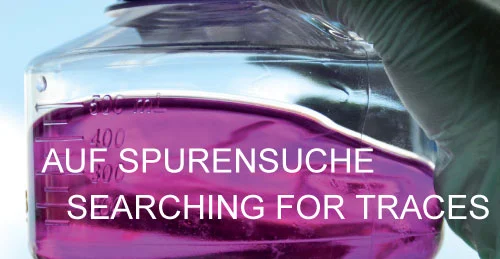Searching for traces: Bioanalytics identifies materials
Explosives in the travelling bag? Lead in the rubber duck? Hormones in the river water? Questions like these can be put to the Federal Institute for Materials Research and Testing (BAM), for instance Professor Ulrich Panne. There he is head of the Analytica lChemistry Department. Panne is convinced: “Sociopolitical controversies like those concerning food safety or public places lend themselves to sensible solutions only when there are reliable analytical data to go on.” To his chemist’s mind this means breaking down the composition of substances with great precision.
The field of bioanalytics, for instance, utilises the very selective propensity of large biomolecules like enzymes orantibodies to bond only with certain substances according to the key-lock principle. They can therefore be used as tools, also coupled with microchips, for detecting these substances. On this principle, researchers at BAM succeeded in detecting minute quantities of an antiepileptic in the rivers and lakes of Berlin. To this end, they developed a new test with antibodies.
The advantage lies in the biological sensors: They are so small and cost so little, that many hundreds or thousands of water samples can be analysed at the same time. Adlershof has a long tradition of success in instrumental analysis and scientific instrument making, a tradition that is tending towards better, faster, smaller and so more mobile and more individualised. “Particularly in the life and material sciences, the rapid commercialisation of findings from basic research is closely linked to improved and faster analytics,” explained Panne. And the wide range of functions and interactions presented by these complex new substances must be clarified to the greatest possible extent.
Analyses return qualitative results on the type of detected constituents, and quantitative results on their concentration and the uncertainty involved in the measurements. Often the traces looked for are minimal. “The sensitivity of our equipment can be measured in only a few parts per billion,” explained Dr Dirk Rondeshagen of the IUT, an environmental technology institute. “That’s like picking out the only German tourist among a billion Chinese,” he added.
The IUT develops customised sensors and systems for the analysis of gases, for instance in containers from overseas. These are often filled with toxic gases like methyl bromide, hydrocyanic acid or phosphine that are to prevent fungi, beetles and other pests from spreading all over the globe or damaging the goods. Since very recently, the health of workers opening these containers has been safeguarded by the system Fumi Detec. Simply a small lance with hose is inserted through the door gasket, and the system presents data on the type and concentration of gases inside. The mobile device ionises the captured gas particles and accelerates them through an electric field. Each gas type can then be identified on the basis of its characteristic runtime.
by Uta Deffke
